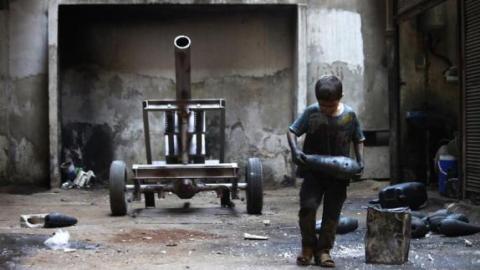Born in Aleppo in 1990, photographer Hamid Khatib began covering the uprising around the time it became militarized. He recorded many videos of protests before switching to documentary photography. Hamid Khatib joined the uprising in October 2011, after completing his obligatory military service. He attended numerous demonstrations in Aleppo and its countryside for six months, before moving to the United Arab Emirates for work.
When military action began to take place in Aleppo, Khatib traveled back incognito, to document the terror Syrians are withstanding. He then started to contact international news agencies at the recommendation of other photographers. Kahtib explains what the uprising means to him saying, “there is no Hamid the photographer without the revolution. Hopefully there will still be one when the revolution ends. It's because of the Syrian revolution that I have found the woman I love, and I will never forget that.”
His renowned photo “Rebel boy makes weapon” was chosen by Reuters as one of the best pictures of 2013. Since then, he has been working for the news agency capturing moments of destruction, hope, despair and daily terror carried out by the Syrian regime. The award-winning photograph shows a 10-year-old boy named Issa, carrying a shell in a weapons factory of the Free Syrian Army in Aleppo.
“I took this photo while working on capturing the effects of war on children and Issa's story was one of many, but this particular one has come to mean a lot to me, on a personal level. I was struck to witness how war forces a young child to work in a weapons factory, 10 hours a day, six days a week.” says Khatib in an interview after receiving the award.

But the day he literally escaped death was on his first day back in his hometown Azaz in northern Aleppo, which he had not visited for three years. “I was asleep when it happened,” he says, as he recounts the story of his survival, “when battles began to take place in Aleppo, my parents moved back to Azaz, and I stayed. That day I was visiting my family who were sharing a two-story house with five families of our relatives. I stayed up all night in shock at the amount of destruction I witnessed in my town. In the morning, I was awoken by shelling to find myself covered in glass splinters. I ran downstairs to check on my family, and found them crying in fear that the men upstairs had been killed. The missile had fallen on a neighboring street, then another shell followed. 150 people were killed that day, and 40 houses were turned into rubble.”



